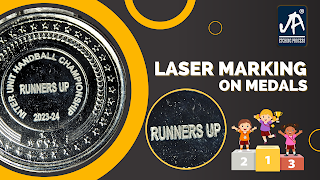Laser Marking: The Ultimate Guide to Permanence
In today's fast-paced industrial landscape, laser marking has become a fundamental technique that offers permanence, precision, and versatility. Whether you're a manufacturer, engineer, or simply curious about this cutting-edge technology, this guide will unveil the wonders of laser marking and its applications. Additionally, we'll explore how laser marking interacts with PTFE non-stick coating and the revolutionary 5-axis laser technology.
Laser Marking
Demystified
What is Laser
Marking?
Laser marking is a method that uses a high-energy laser beam
to alter the surface of a material, creating a permanent mark or engraving. It
stands out for its accuracy, durability, and ability to produce intricate
designs and patterns on a wide range of materials, from metals and plastics to
ceramics and glass. Unlike traditional marking methods, laser marking does
not involve the use of inks, dyes, or physical contact with the material,
making it cleaner and more efficient.
The Process of Laser
Marking
Laser marking is achieved through the selective heating and
vaporization of the material's surface. This controlled energy application
results in permanent marks, whether they are for branding, identification, or
decoration. The laser beam can be fine-tuned for various marking styles, from
surface ablation to deep engraving, ensuring a perfect match for your specific
application.
Applications of Laser
Marking
Laser marking finds
applications across numerous industries:
Manufacturing: In
manufacturing, laser marking is widely used for product labeling, traceability,
and quality control. It's employed for marking serial numbers, barcodes, and
other essential information on parts and products.
Aerospace and
Automotive: Laser marking is essential in the aerospace and automotive
sectors for part identification and compliance with strict industry standards.
Medical Devices:
In the medical field, laser marking ensures permanent and safe product labeling
on surgical instruments, implants, and medical devices.
Electronics:
Laser marking plays a critical role in the electronics industry, marking
circuit boards and components with precision.
Jewelry: Jewelry
designers and manufacturers use laser marking to personalize pieces, creating
intricate designs and inscriptions on precious metals.
The Marriage of Laser
Marking and PTFE Non-Stick Coating
PTFE (Polytetrafluoroethylene) non-stick coating is renowned
for its exceptional non-stick properties, high resistance to heat and
chemicals, and durability. When paired with laser marking, it adds an extra
layer of functionality and aesthetics to various products.
Aesthetic Enhancements: Laser marking, in combination with PTFE non-stick
coating, allows for personalized and branded cookware, bakeware, and
kitchen tools. The result is not only practical, with non-stick properties, but
also stylish and memorable.
Functional Benefits: In the industrial and manufacturing
sectors, PTFE-coated parts can be marked with laser markings, ensuring precise
identification and traceability while benefiting from the coating's non-stick,
heat-resistant, and chemically resistant qualities.
Revolutionary 5-Axis
Laser Technology
Traditional laser marking methods involve a fixed laser and
a stationary workpiece. In contrast, 5 axis laser
technology is a game-changer. It allows for the precise and dynamic positioning
of the laser head, offering more flexibility and enabling the marking of
complex, three-dimensional surfaces.
Advantages of 5-Axis
Laser Marking:
Complex Surface
Marking: With 5-axis technology, you can mark surfaces with intricate
contours, such as molded parts, curved tools, or medical devices with complex
geometries.
Improved Efficiency:
The ability to mark multiple parts simultaneously or to mark a single part from
various angles significantly improves efficiency in industrial settings.
Enhanced Aesthetics:
For products with curved or non-planar surfaces, 5-axis laser marking ensures
that markings and designs are crisp, clear, and aesthetically pleasing.
Conclusion



Comments
Post a Comment